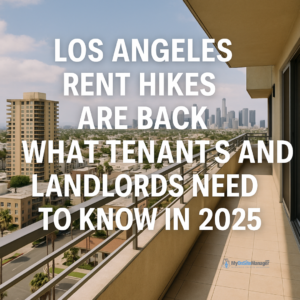For the first time in more than three years, many Los Angeles renters under the city’s rent stabilization ordinance (RSO) are seeing their monthly costs go up.
When the city lifted its COVID-era rent freeze on February 1, 2024, landlords regained the ability to raise rents some by as much as 6% depending on whether utilities are included in rent.
Under RSO, landlords can raise rent by 4%, and add an extra 2% if they cover both gas and electricity. While that formula is decades old, it’s once again determining what thousands of Angelenos will pay in 2025.
Why Rent Increases Are Happening
The return of higher rent caps comes down to a mix of policy delays and inflationary pressure.
Los Angeles city officials and housing advocates have debated whether the current formula is outdated, especially as inflation and rising utility costs distort what landlords and tenants consider fair.
A new report commissioned by the Los Angeles Housing Department recommended a revised inflation measure that would cap increases closer to 2%, aligning more closely with cost-of-living trends. However, the City Council hasn’t yet voted on the proposa lmeaning the old system remains in effect.
Tenants Caught in the Middle
For many renters, especially those living paycheck to paycheck, even a small percentage increase can be crushing.
According to city data, over half of L.A. renters spend more than 30% of their income on housing. The new hikes could push thousands further into financial instability or displacement.
Tenant rights groups are urging the City Council to act before February 1, 2025. “Delaying this decision means more families struggling to stay housed,” one advocate told LAist.
They argue that while landlords face higher maintenance and insurance costs, tenants shouldn’t bear the full weight of Los Angeles’ affordability crisis.
Landlord Concerns: Rising Costs and Maintenance Burdens
Landlords, on the other hand, emphasize that operating expenses from repairs to property insurance have increased significantly. Many say a 6% cap doesn’t even cover the rise in costs they’ve seen since the pandemic.
Some landlord associations have called for flexibility to raise rents up to 9% to match true inflation and maintenance costs. Without that, they warn that smaller property owners could struggle to maintain older buildings safely.
Proposed Policy Changes Under Review
The Economic Roundtable, a local think tank, recently submitted its study recommending updates to the city’s rent-adjustment formula.
Key proposals include:
-
Replacing the current Consumer Price Index (CPI) used to calculate rent increases with a more housing-specific inflation measure.
-
Eliminating the 2% utilities bump, since the additional rent increase often exceeds the actual cost of gas and electricity.
-
Introducing more predictable, long-term rent-stabilization schedules to help tenants and landlords plan better.
These changes would make Los Angeles rent policy more in line with other large cities like San Francisco and Oakland, which have adopted similar caps.
Looking Ahead: What Tenants and Landlords Should Expect
If the City Council fails to approve updates before February 1, 2025, the existing rent-increase formula will stay in place allowing for a 4% to 6% rise.
That means both tenants and landlords should prepare:
For Tenants:
-
Review your lease and check whether your unit falls under the RSO (generally, buildings built before October 1978).
-
Expect potential increases and ensure you receive the proper 30-day written notice.
-
Reach out to the Los Angeles Housing Department or local tenant-rights groups if you believe your rent hike exceeds legal limits.
For Landlords:
-
Review the latest RSO compliance rules before issuing any rent adjustments.
-
Clearly document how you calculate increases, especially if utilities are included.
-
Stay alert for possible City Council action that could modify allowable rent levels.
The Bigger Picture
This moment represents a critical test for Los Angeles housing policy.
The city faces one of the nation’s most severe affordability crises, with vacancy rates under 4% and homelessness still rising. Striking a balance between keeping housing sustainable for landlords and livable for tenants is more important than ever.
Whether or not the City Council acts soon, February 2025 will mark another turning point in how Los Angeles manages the tension between market pressure and housing justice.
Source: LAist – “Los Angeles Rent Control Limits Rent Hikes for Tenants and Landlords”

